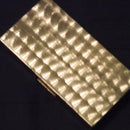Introduction: Brass Hammers
A medium sized brass hammer is a useful addition to any tool collection. A brass hammer will not damage things like steel pipe threads or cause sparks like a steel hammer will. I made these three brass hammers from one piece of brass rod I bought at a salvage yard. When I bought it, I really didn't know what I was buying it for. When I studied it, I decided to make the bottom hammer.
I turned it on an old lathe I have and then drilled a egg shaped passage for the handle with my milling machine. I then bought a wooden handle and fit it into the hammer head using epoxy, a wooden wedge and a small steel wedge. That hammer became one of my most used tools, so I decided to make 2 larger hammers, but in making them, I only sawed the brass rod into two halves and drilled holes for handles. They are the 2 on the top.
Please understand that although I only made these 3, I included some photos of other type of hammers to show comparison to the brass ones.
Step 1: 1 Brass Rod = 3 Hammers
The first photo shows how the original rod looked before I cut it into 3 pieces. I could see no reason to reduce the size of the two bigger hammers, so I left them "unfinished" after cutting them into two pieces. I have been glad I did. The longer one gets into smaller spaces with more weight, and the one with the knob on the end is massive enough for bigger jobs. I included the claw hammer in the 2nd photo to give a perspective on the size of the brass ones.
Step 2: The Ball Peen Hammer
Peen: (noun) def: the end of a hammer head opposite the face, typically wedge-shaped, curved, or spherical.
Every tool collection needs several ball peen hammers of different sizes and at least 1 medium sized brass one. I shaped this one on a lathe and fitted on a new handle using epoxy, a wooden wedge in line with the head and a steel wedge 90º across the wooden wedge. I use this hammer everyday in my shop.
The 4th photo shows some of my steel ball peen hammers, but they are not used as often as the brass one. Surprisingly, the smallest is used almost as much as the bigger ones.
Step 3: #2 Hammer
This is the 2nd one I made. It is used often, but not as much as the ball peen.
Over time, the face of a brass hammer will "mushroom", meaning it will change shape and flare out similar to the look of a mushroom. That is better than ruining all your punches and chisels with a steel hammer. When that happens to your brass hammer, it is easy to grind off the flare, restoring it's shape. The 2nd photo shows how this hammer is flaring out. You can also see the marks where I ground it off previously.
Step 4: #3 / Heavy Weight
This was the remains if the original brass rod after I made the first 2 hammers. I decided to leave it "as is" and put a handle on it. It has been a great addition to my tool collection. I have nothing else like it and do not use it often, but there are times when nothing else will get the job done.
If you don't have the tools or resources to make one, you can buy one at about any tool supply dealer such as Harbor Freight or eBay, but half the fun of having and using a good tool is making the tool in the first place. Also, they cost more than steel hammers because brass is expensive.

Participated in the
Hack Your Day Contest











